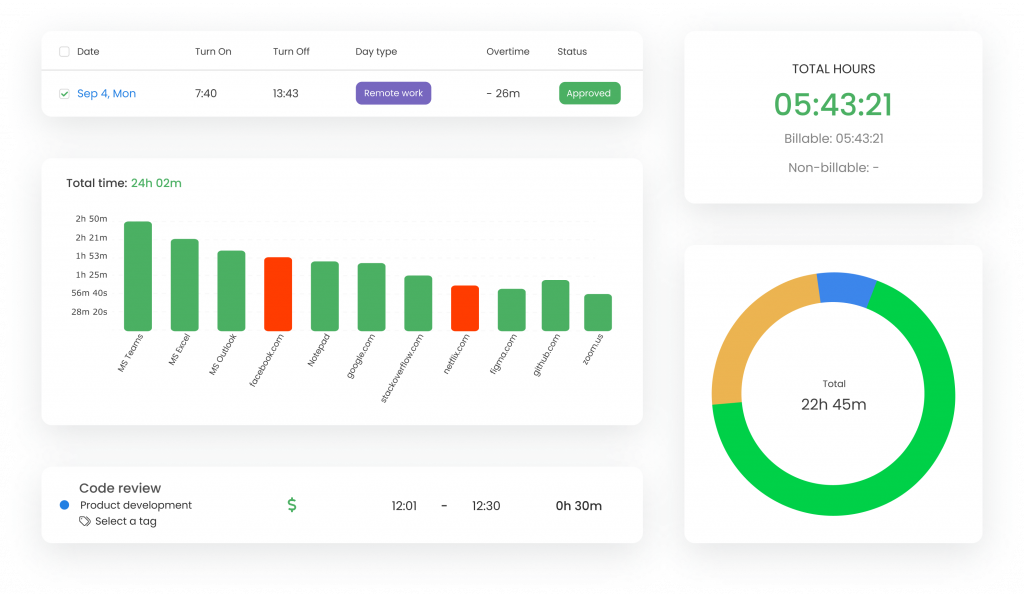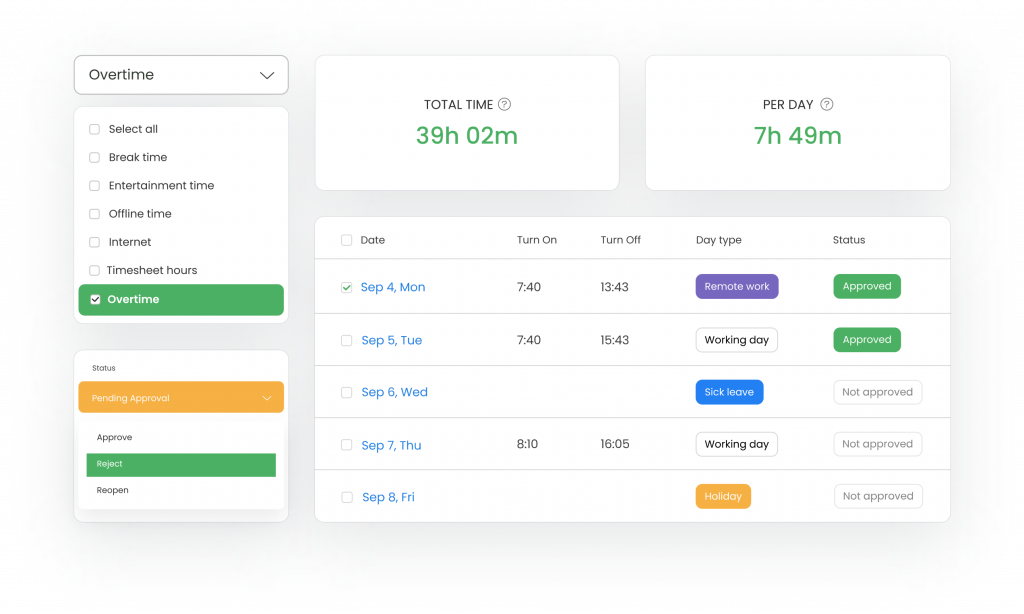Employee lateness – how to deal with it?
-
Kat Ciesielska
- 2024-07-12
- 8 min read

Employee lateness is not as rare as it used to be. According to a survey prepared by CareerBuilder, 29% of employees are consistently late—at least once per month. Moreover, younger employees are more likely to be late than older ones. If you’re a small business owner or manager, you surely want to deal with the problem. Let’s check out how you can handle employees’ tardiness without turning into a boss no one likes.
Tardiness problem solved
Track clock in and clock out hours automatically with TimeCamp
Employee lateness cost
Before we go further, let’s think about the money your company loses because of late employees.
Studies show that each minute an employee arrives late costs business owners $2 and $2.50 in lost productivity and revenue potential; meanwhile, a full hour of employee lateness costs up to $1,000 per person.
Whether enterprises are not affected that much, employee tardiness may cause serious revenue loss for small businesses.
Also, due to things like lower employee morale among other employees and the lost opportunity to network with clients or vendors during lunches outside the office.
How to detect late employees?
Before dealing with employee lateness, you need to find out who is late and how often. Without these data, there is no way to encourage employees to arrive on time. Back then, it was not so hard when almost every organization worked offline. Employees just showed up, typically using some card to check in at work.
But even if it was working like that these days, how would you know that employee had started working already? They could go for coffee, gossip, or whatever else.
The right time-tracking software is your answer. It will easily and quickly detect all chronically late employees. And that’s not all. You will also find out their patterns to better understand them. Employee lateness always has its source.

How to address lateness with an employee?
Let’s say that you have already detected chronically late employees. So, what’s next? How do we take the first step to dealing with this problem? Keeping these arriving late workers in your organization means you find them useful after all.
How to address this issue without making anyone feel uncomfortable?
All your team members are people like you and me. The best idea is to start by talking. Simply ask them why they struggle to meet the time they should clock in at the workplace daily.
Honest conversation
Conversations with late employees are a must before introducing any disciplinary actions. Perhaps they have had some problems recently. Employees’ behavior is always affected by their private life, and you can’t forget it. Being professional is one thing, but having a sick partner, parents, children, or animal is second.
There is also stress, chronic tardiness, and poor work-life balance (and it may, but doesn’t have to, be your fault).
Arguments with other staff members can also be a reason. Employees who are late may
What’s important to understand is that a tardy employee may develop an ergophobia, a work phobia. Excessive tardiness at work can also be a symptom already. Sounds funny? Well, it’s not at all. It’s an existing disease, similar to school phobia, and it’s a type of anxiety neurosis. Not being treated can destroy one life.
That is why detecting your employee’s working patterns will not only help you… it can help them.

Respond thoughtfully
Employee lateness disturbs you, yes. The first thing to do is to be careful not to overreact but to provide employees with crystal clear reasoning. If you’re feeling angry, take a few minutes and calm down before you confront an employee about their lateness.
You don’t want your emotions interfering with how you handle the situation and ending up saying something that could get you into trouble later on down the road. This is especially true if the employee’s tardiness is caused by something other than oversleeping, e.g., severe traffic, public transportation delays, really bad weather, or a broken subway (again).
You could always say that other employees can manage to be on time despite traffic… but maybe late employees live in a place where it’s a more significant issue.
There can also be many other unforeseen circumstances, and if you get angry, you will achieve just one thing… your employee won’t be honest with you next time. And that’s not what you want to achieve.
Establish clear employee lateness policy
Establish a written policy to address employee lateness by specifying the rules and consequences of tardiness. Ensure that your policy is clear and easy to understand and that it’s applied consistently as a part of the work culture in your company. You can’t expect people to follow all the rules if you are inconsistent in enforcing them.
While preparing your lateness policy, remember about unforeseen circumstances. Usually, people would rather not be late for work. It happens because of something. Every company policy needs to consider reality and implement a fair work ethic.
Explain it thoroughly at orientation or training events to ensure that employees understand it, and then take disciplinary action when necessary. Clear expectations are easier to follow. If someone is regularly late, remember to talk to them in private. There’s no need to embarrass anyone.
Stick to company policies as a boss
Moreover, remember that you need to obey the rules as everyone else. After all, you want to be a leader, not a dictator. Your entire team should feel a mutual respect. Arriving late every day just because you are a business owner or manager won’t help you. Show them a good example. Don’t hide your own behaviors. Creating transparency in the workplace is always a good idea!
If there are many late employees, hold regular meetings and conversations with your employees about their tardiness habits.
Remind yourself that every employee deserves a fair chance at success—the ability to be punctual isn’t easy for everyone!

Serve a warning
The first step in dealing with a habitually late employee is to issue a warning. Explain why you are issuing the warning and what will happen if the behavior continues. Consistently late employees need to understand that you notice their behavior but also allow them to improve.
Try to give the employee a chance to explain their lateness, but don’t let them use this as an excuse for further tardiness or absences.
However, avoid disciplinary actions such as docking pay period or even termination, especially if you don’t know the reason behind the employee’s lateness. Check also their performance reviews—maybe they struggle to arrive on time, but their account has no missed deadlines.
First, if they tend to arrive late (or after the shift begins), remind them of the company’s policies regarding their work schedule. If that doesn’t work, consider adding to their workload, for example. Sometimes, working past clock-out times for a few days straight truly works wonders.
Help late employees learn how to be on time at work
Most bosses just want to deal quickly with employee tardiness, but they forget to look at this problem from an employee perspective. If one is always late for work, they may have serious problems with time management… or employee tardiness.
There are a few ways to help your people. You can hire a psychologist to calm your staff, send employees for some time organization training, and implement a motivating bonus system for those who clearly try… but!
There is one thing that will help more (as it also lets you implement other strategies): tracking time.
Is time-tracking effective? Oh, yes.
Support employee tardiness policy with employee attendance management
Every strategy begins with analyzing data, and every piece of data needs to be collected first. Good employee time and attendance management software—like TimeCamp—guarantees data.

The automated app collects information about how the employees spend their working hours. The conclusions drawn from analyzing data work way better for preparing performance reviews than a survey conducted by managers with their team members during a team meeting.
You will learn:
- when they log in (turn on the computer),
- what tasks they work on and for how long,
- what distractions affect them and how often,
- when they take breaks,
- when they finish work,
- and more.
You can also generate complex reports with just a few clicks! It couldn’t be easier, really. Both for office and remote workers. They’ll also improve the decision-making process on how to deal with employee tardiness without the necessity of issuing any disciplinary action.

With all this data, you can help your chronically late employees understand how often they actually come late to work. It is highly possible that they don’t even know it. You can also fight employee tardiness by not letting them work longer than 8 hours per day. Many remote workers like to work longer than necessary. And the effects? They are going to be late the next day and get burned out in the longer perspective.
Get to know where your time goes with TimeCamp!
Track time in projects and tasks, create reports, and bill your clients in just one tool.
Consider implementing flextime
Yes, employee lateness can be very hard to handle, especially if the persistently late employee is a great specialist in their field. Instead of sending written warnings one after another, you could consider flexible working schedules.
A huge number of businesses aren’t so tied to the schedule. Late arrivals won’t be a problem if you simply change the policy of working hours. Does it sound crazy? Maybe, but these days, when we have so many tools, it’s possible. Your employees can work at different times than you – you can check their progress with time-tracking software, for instance.
Flexible schedules are a great idea, especially if you have many night owls on your team. Being on time at 8 AM is real torture for these chronotypes. They won’t be very useful; their performance will be poor. And it’s not because they are lazy. They have just different bodies, and that’s perfectly natural. Over 30% of people are defined as owls.
You want them to start their working time after morning birds. Trust me.
But again, how can you be sure they are doing their job when you or your managers are already eating dinner with their loved ones?
Flextime tracking
Highest employee efficiency, zero micromanagement
Be patient (if possible)
After introducing your new lateness policy and helping these habitually late employees handle the issue… wait. Be patient and give those who are usually late for work some space. You have some valid reasons to keep them, so don’t rush the process.
Eliminating tardiness can take even more time if they experience personal problems. Just because one employee learns time management quickly doesn’t mean the rest will do it simultaneously.
Chronic attendance problems are challenging to fight. However, if you remain calm and patient, you will get better results—trust me.
Reward improvements
It is obvious that you need to address the problem, but never forget to recognize improvements. Nothing is worse than someone who points out one’s mistakes and never notices improvement.
For chronically late employees, improving was not an easy task. It could have been harder than you imagine. Especially if you’re a punctual person.
Ask the staff member who recently stopped being late or drastically more often is on time—even if you can’t consider him one of the punctual employees yet.
Other team members will notice it, and it will surely boost their morale and positively impact productivity and employee engagement. If one chronically late employee could do this and start being punctual, they could, too!
Conclusion
Traffic jams, medical issues, or some personal reason. Many factors cause employee lateness. Hence, you need to use different strategies to handle it. But some tips always fit. Honest conversation, keeping a proper work ethic, patience, and… collecting data from and analyzing them 😉
Get to know where your time goes with TimeCamp!
Track time in projects and tasks, create reports, and bill your clients in just one tool.


